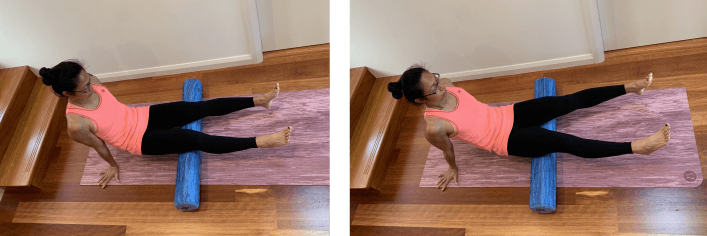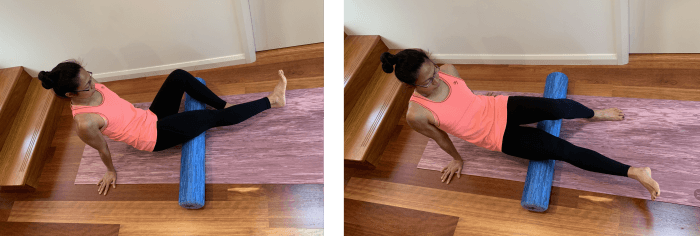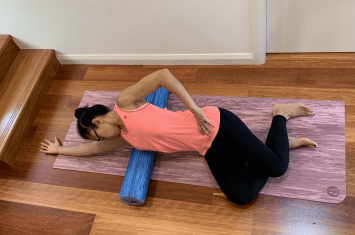Foam Roller
Discover how the foam roller can help you warm up better, recover faster after exercise, and help you move better.

Would you like to move around more freely?
Ever felt a bit of muscle tightness after a workout or exercise?
Have you ever had a knotted muscle, and no matter how much you try to stretch, you just can’t seem to get it out?
Have you ever experienced delayed onset of muscular soreness (DOMS)? This is the pain and stiffness in your muscles that typically happens 24 to 48 hours after an intense workout that can last for a few days.

Using a foam roller or the technical term self-myofascial release is used for self-massaging muscle tightness, and muscle knots, also referred to as trigger points. This is done by applying pressure to the affected area using various tools and techniques. The most commonly used tool is a cylinder-shaped foam roller.
Implementing self-myofascial release as part of your training routine is an effective and inexpensive way to increase mobility, flexibility, and performance, reduce muscle soreness, prevent injuries, and help to assist in reducing muscle imbalances.

How does foam rolling or self-myofascial release work?
Our muscles have a thin layer of tissue that covers them called ‘fascia’. Fascia can get tight through exercise or lack of exercise, overuse, injury, or physical imbalances such as poor posture.
Using tools like a foam roller allows us to self-massage the affected areas to relieve muscle soreness and tightness.
Fascia requires efficient blood flow to function properly and remain healthy. Due to the things listed above, restricted blood flow results in muscle tightness and pain. Self-myofascial release helps to keep the fascia healthy by circulating fresh oxygenated blood through it. By keeping the fascia healthy, the better you can move.
Is self-myofascial release easy to do?
Yes, self-myofascial release is relatively easy to do.
Foam rolling can be done before a workout, during the warm-up, to improve range of motion, or after a workout to relax tight muscles and reduce the soreness to aid muscle recovery. It can also be done anytime to help prevent any muscular problems from occurring or help to reduce the wear and tear of everyday living.
There are three general techniques - Rolling, Spans, and Stretching
Rolling
Roll back and forth over an area of the body a few inches at a time.

Spans
When you hit a trigger point, move side to side until you feel relief.

Stretching
Find a trigger point and hold while stretching the muscle to a full range of motion. This technique will help increase circulation and mobility.

Simply roll slowly by applying moderate pressure over a muscle group using just your body weight and the foam roller. Just pause for several seconds when you find a tender or painful area. If it’s too painful to roll over, just foam roll the surrounding areas to loosen up the entire area gradually.
I use a foam roller before and after a workout for around two to five minutes or so on areas of the body that feel tight or need to be mobilised. I generally spend 20 to 60 seconds on a particular area and then move to another area.
Which foam roller or tool should I use?
Foam rollers come in different shapes, sizes, lengths, and foam densities. Choosing one comes down to personal preference, what you’re going to use it for, your weight and height, and your level of experience. A soft to medium density foam roller is easy to use and better when starting out.
I use a medium density foam roller that is 90cm (36”) in length and 15cm (6”) in diameter.
Apart from a foam roller, I also use a tennis ball and golf ball, which helps to isolate a particular trigger point.
How often should I foam roll?
Try foam roll at least three times a week for best results, but foam roll as often as you need. I have not come across research suggesting that foam rolling can be harmful too often.
How long should I foam roll for?
We like to foam roll over an area for about 20 to 60 seconds at a time. You can foam roll for longer or shorter or as long as it feels good or until you get an adequate release.
Things to pay attention to
A foam roller and other tools alike are inexpensive and relatively easy to use. That said, you should pay attention to a couple of things.
Firstly, pay attention to your body. If you are foam rolling on an area that doesn’t feel right or there is pain that gets worse, best to see your physician or physiotherapist to find out if there is an underlying problem.
Secondly, avoid foam rolling over sensitive areas or joints like the neck, lower back, and knee joint.
For more information on foam rolling or self-myofascial release, please visit TriggerPoint.